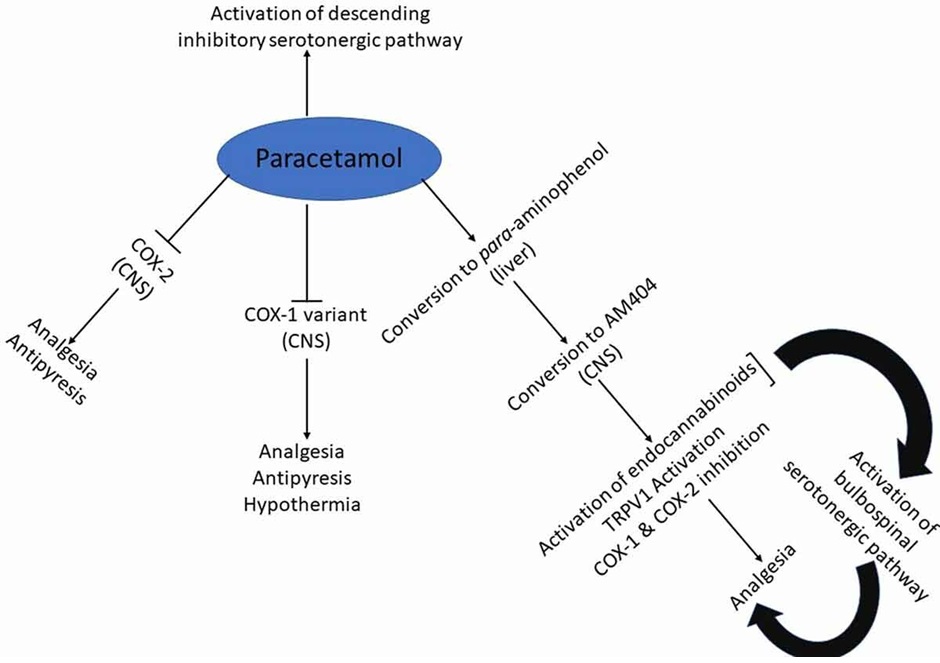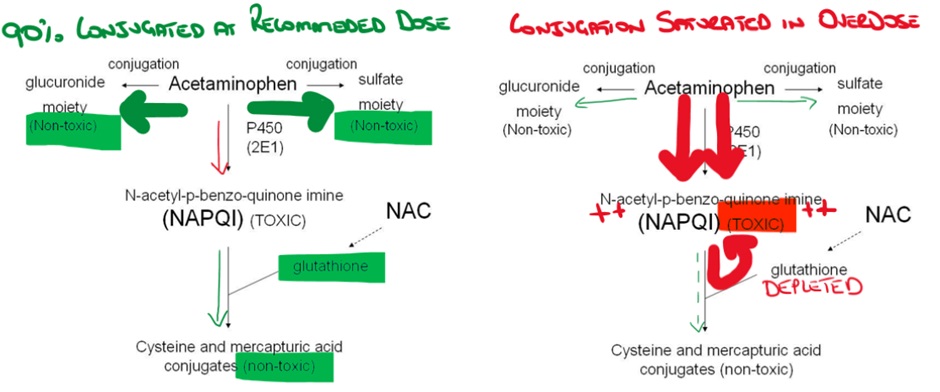10.3 Paracetamol
Paracetamol
Paracetamol (Panadol) is also known as acetaminophen.
Alongside aspirin and ibuprofen, paracetamol is the most widely used drug to treat mild to moderate pain and fever.
The exact mechanism of action of paracetamol is not fully determined. The analgesic effect of paracetamol may involve inhibition of central PG synthesis (?via COX inhibition) and activation of descending inhibitory descending serotonergic pathways. Inhibition of calcium channels and interactions with TRPV1 and cannabinoid receptors many also contribute to the effects of paracetamol.

The antipyretic effect of paracetamol is most likely due to reduced production of PG (?via COX inhibition) in the hypothalamus similar to NSAIDs.

Paracetamol possesses very limited anti-inflammatory effects and is therefore not an NSAID. It also fails to exhibit the typical side effects known to occur with NSAID use.
Paracetamol has good oral bioavailability, is well tolerated and easily accessible to patients. Rarely, paracetamol can cause skin reactions. Long-term use (eg >2kg lifetime use) can lead to chronic tubulointerstitial nephritis, known as analgesic nephropathy which is also known to occur with NSAIDs.
Paracetamol Toxicity
Each year in Australia around 225 people are hospitalised with liver injury and 50 Australians die from paracetamol overdose, with rates of intentional overdose highest among adolescents and young adults. Accidental or intentional paracetamol overdose is the leading cause of calls to poison information hotlines in Australia and New Zealand.
Read this media release that outlines changes to paracetamol availability in Australia from 2025. TGA makes final decision to reduce paracetamol pack sizes | Therapeutic Goods Administration (TGA).
The regular dose of paracetamol is 4g daily (in adults >50kg) and doses greater than 7.5g are associated with hepatotoxicity whilst ingestion of over 15g is lethal.
Metabolic pathways involving paracetamol:
- Glucuronidation and sulphation pathways form harmless conjugates that are excreted in the urine. This accounts for about 90% of paracetamol metabolism. However this pathway is saturable and high paracetamol doses leads to pathway 2.
- Through mixed function oxidase (CYP450) enzyme system, N-acetyl-p-benzo-quinone imine (NAPQI) is formed. NAPQI is highly hepatotoxic but it is normally detoxified by conjugation with glutathione.
- Glutathione reserves are limited and the exhaustion of glutathione leads to NAPQI accumulation and liver cell death.

NAC acts by promoting hepatic glutathione synthesis. It is most effective when administered within 8 hours of overdose but there is benefit when given up to 48 hours after ingestion. Serum paracetamol concentrations help to guide the rate and duration of NAC administration.
🎥 Watch this video
COMMONWEALTH OF AUSTRALIA Copyright Regulations 1969 WARNING This material has been reproduced and communicated to you by or on behalf of James Cook University in accordance with section 113P of the Copyright Act 1969 (Act).
The material in this communication may be subject to copyright under the Act. Any further reproduction or communication of this material by you may be the subject of copyright protection under the Act. Do not remove this notice.
